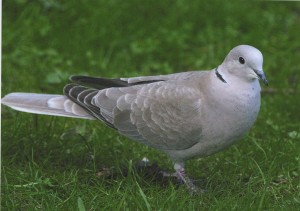 Collared doves look like a streamlined version of the wood pigeon with a long tail and whilst we readily accept them in gardens and parks we tend to forget their remarkable history in the Highlands. This is a pale pinkish buff dove that looks delicate and vulnerable but its looks belies its life style. The back is plain and unmarked but the degree of brown colouring is very variable with some individuals looking more grey than brown. In flight the most obvious feature is the broad white band at the tip of the tail. Most birds have a thin line of black feathers on the sides and back of the neck but the length and width is variable. This black neck marking is absent in juvenile birds. In the last two years, for some unknown reason, one or two leucistic collared doves have been seen near Inverness. This is a colour abnormality in which there is a partial loss of pigment and the whole plumage looks washed out although the basic pattern remains so that the bird can be identified. One unusual feature is the length of moult as it starts in the spring, after March, and continues into the Autumn. Then the moult seems to halt and the flight feathers do not completely re-grow until the following February. With most birds the complete moult is over as quickly as possible but with the collared dove it can last for an incredible ten months.
Collared doves look like a streamlined version of the wood pigeon with a long tail and whilst we readily accept them in gardens and parks we tend to forget their remarkable history in the Highlands. This is a pale pinkish buff dove that looks delicate and vulnerable but its looks belies its life style. The back is plain and unmarked but the degree of brown colouring is very variable with some individuals looking more grey than brown. In flight the most obvious feature is the broad white band at the tip of the tail. Most birds have a thin line of black feathers on the sides and back of the neck but the length and width is variable. This black neck marking is absent in juvenile birds. In the last two years, for some unknown reason, one or two leucistic collared doves have been seen near Inverness. This is a colour abnormality in which there is a partial loss of pigment and the whole plumage looks washed out although the basic pattern remains so that the bird can be identified. One unusual feature is the length of moult as it starts in the spring, after March, and continues into the Autumn. Then the moult seems to halt and the flight feathers do not completely re-grow until the following February. With most birds the complete moult is over as quickly as possible but with the collared dove it can last for an incredible ten months.
The collared dove had spread from its original breeding areas in Asia to reach India and South East Europe by the sixteenth century. Then for some unknown reason the spread abruptly halted and it remained static until 1930. Then, again for some unknown reason, it suddenly started expanding westwards at a rate of a 1,000 miles every twenty years. It bred in England in 1955 and Scotland in 1957 at Covesea, Moray, where birdwatchers from all over Scotland travelled to see the birds. Various theories have been put forward for this success story but the most likely seems to be a genetic mutation which enabled the birds to tolerate colder climates. Those first breeding birds were kept a secret so that the public wouldn’t disturb them. Who could have thought how soon they would appear on the list of thirteen birds that can be shot by authorised persons under a General Licence. Now they can be seen throughout the Highlands and Islands although they are absent from most upland areas. Part of their success is not only the fact that they have been found breeding in every month of the year but also they adapt to varying food sources which is why so many gardens, large and small, have them at the bird feeders. There is some evidence that the collared dove is decreasing around Inverness as the maximum count in the area for 2010 was only nine. This may be because of under-recording as it is so common. In one strath just south of Inverness the numbers have not only dropped but the birds’ behaviour has changed. Flocks of between 15 and 20 were often seen but now there are smaller groups in twos and fours and they are very wary. It seems as though the local goshawks and female sparrowhawks have been busy as the collared doves are very skittish even on garden bird tables. Because the bird is such a recent coloniser it has no local names or for that matter no Scots names but it has a Gaelic one, Calman a chrios, meaning “A dove with the wages of a servant”.
